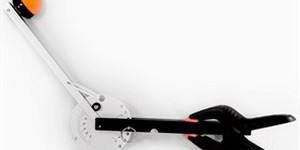Elementary School, Mechanical Engineering Science Projects (32 results)
If you're interested in object motion and enjoy building things or taking mechanical things apart to see how they work, then it sounds like you'd be interested in mechanical engineering.
|
Select a resource
Coding Projects
Sort by
|
Try your hand at this engineering challenge. Can you build a "launcher" device to launch a ball as far as possible and a "receiver" to catch it? Building a receiver provides an extra twist to a traditional catapult project. Add to the challenge by using a limited set of materials to build your machine and calculate a score based on your throw distance and materials used.
Read more
Rubber band paddle boats are a fun bathtub or pool toy that you can build yourself. How do you make a boat that goes the fastest? Find out in this project as you build and test your own boat.
Read more
New
Can AI understand human language? In the future, AI could aid in emergency interpretive service in the hospital when translators aren't available. But can current AI algorithms understand non-verbal languages like sign language? In this science project, you will test whether AI can learn sign language gestures or phrases to see if it can be used for interpretation.
Read more
In this engineering challenge, you will build a device that can pick up a ping pong ball from a distance and return it to a start line. The farther away the ball is, and the fewer materials you use to build your device, the higher your score.
You can see how other students have tackled this and other annual Science Buddies Engineering Challenges.
Read more
Can you lift a car? No? You say you are not strong enough? True, our bodies are not built to lift heavy loads like cars. Fortunately, our brains are smart enough to harness the power of fluids, like water and oil, to create hydraulic lifts. By pushing a button on a hydraulic lift, a mechanic can easily raise a car with one finger. Lifts can also be used to raise lots of other heavy loads - even such massive things as steel girders to construct a skyscraper! In this mechanical engineering…
Read more
Put your engineering skills to the test to see if you can build a machine—powered by nothing but gravity—that will automatically sort out two different sizes of plastic spheres. That might seem like a strange task, but have you ever used a coin sorter to separate pennies, nickels, dimes, and quarters? How about using a sifter in the kitchen to separate fine grains of flour or sugar from bigger lumps? Machines that can automatically sort objects or particles of different sizes are…
Read more
New
Have you ever walked next to your favorite ocean, lake, or creek and seen plastic waste everywhere? Have you ever thought about how much plastic breaks down into microplastics and pollutes waterways? Scientists are coming up with new ways to remove these microplastics from our waterways, and now you can test them out for yourself at home.
Read more
The funny thing about friction is that you couldn't get anywhere without it, yet it still acts to slow you down as you're getting there. Here is an easy project to measure the effects of friction.
Read more
Amaze your friends and family by moving water with just a few turns of your wrist! Nope, it's not a magic trick. It's simply an Archimedes screw. In this science project, you will build a very simple pump, called an Archimedes screw, to transfer water from a low-lying location to a higher location.
Read more
Can you build a volleyball machine? It will need one part to launch a ping pong ball over a net and another to return the ball. How many back-and-forth volleys can you get before the ball touches the ground? Looking for inspiration? You can see how other students have tackled this and other annual Science Buddies Engineering Challenges.
Teachers, lesson plan versions of this challenge are available.
Read more
If you were in a raiding army in the Middle Ages, a catapult would come in mighty handy for taking down castle walls. But only if you could aim it reliably! With this science project, you will try your hand at catapult technology. Using a rubber-band-powered catapult you will send ping pong balls flying through the air. The catapult's design makes it easy to measure and repeat how hard the ball is launched and its direction, so you can find the right catapult settings to hit the target reliably.
Read more
If you have ever been shot with a rubber band then you know it has energy in it, enough energy to smack you in the arm and cause a sting! But just how much energy does a rubber band have? In this experiment you will find out how the stretching of a rubber band affects the amount of energy that springs out of it.
Read more
|

















